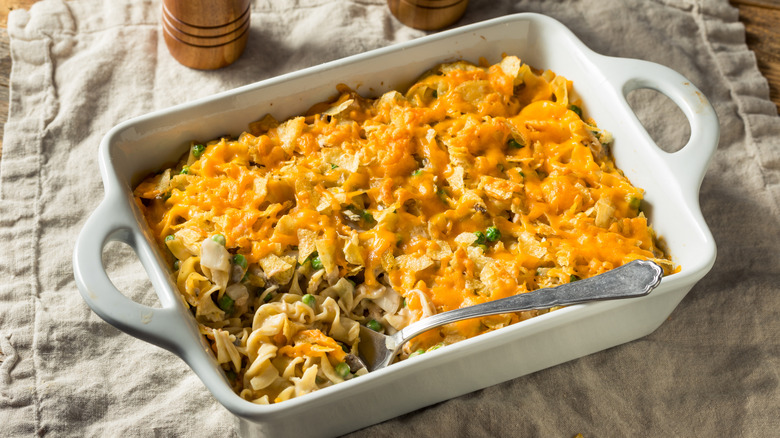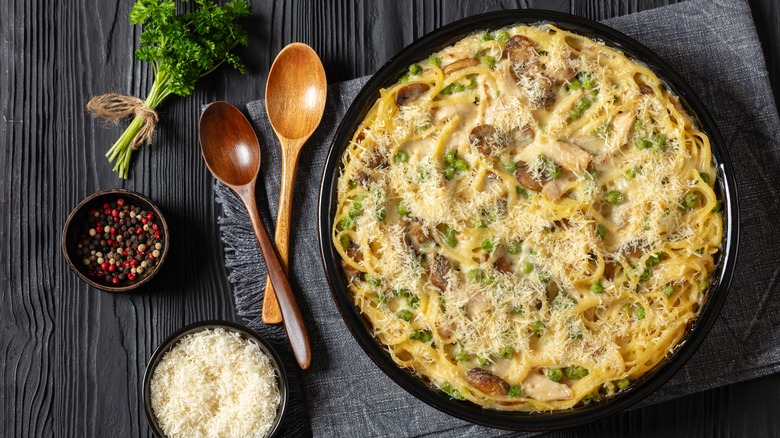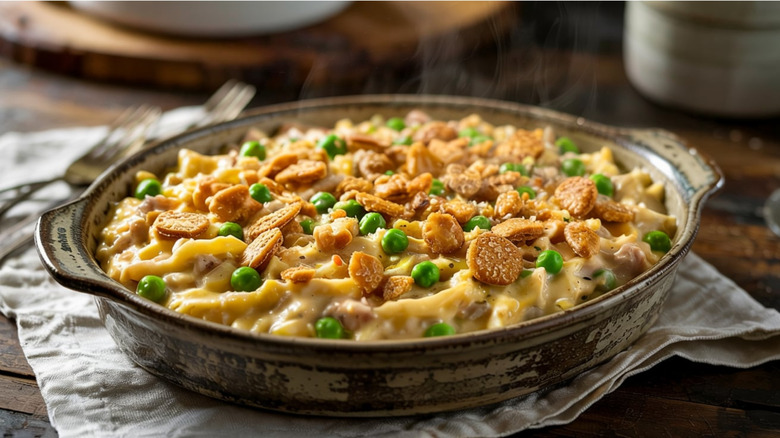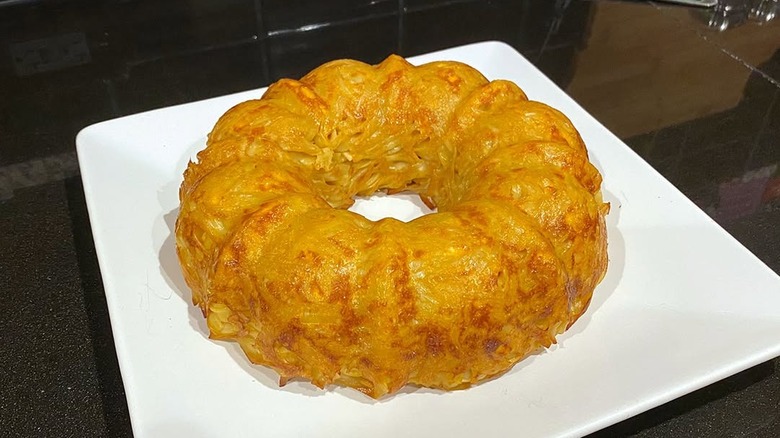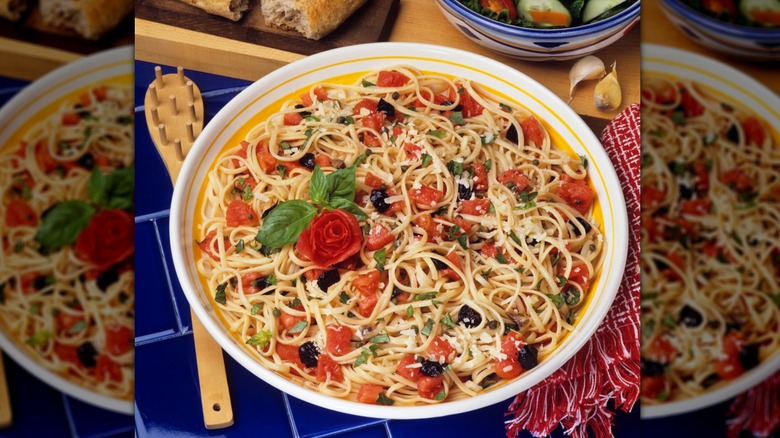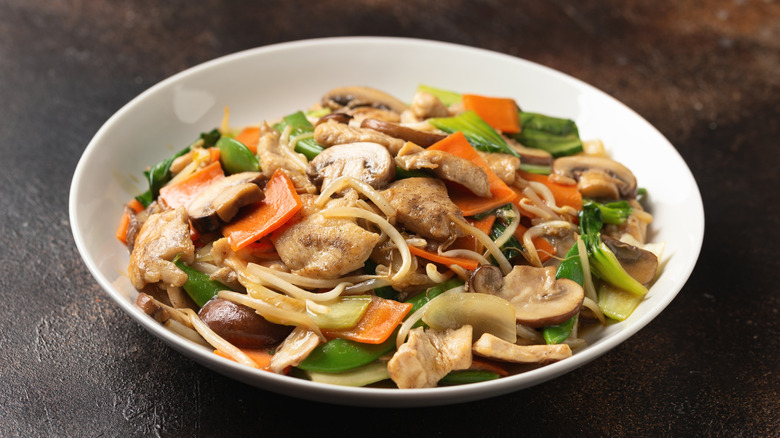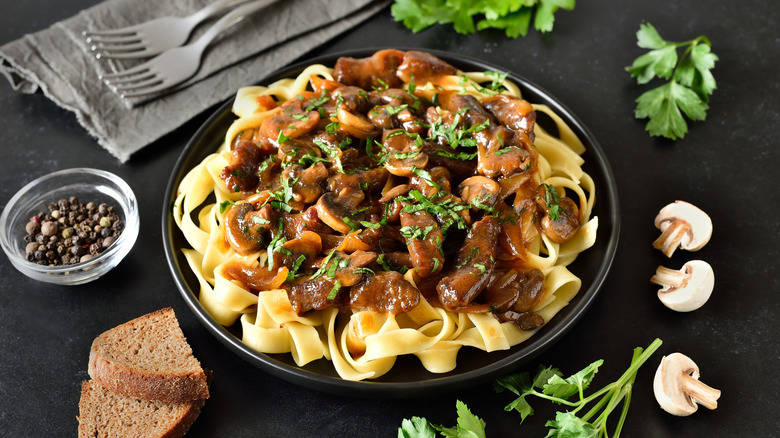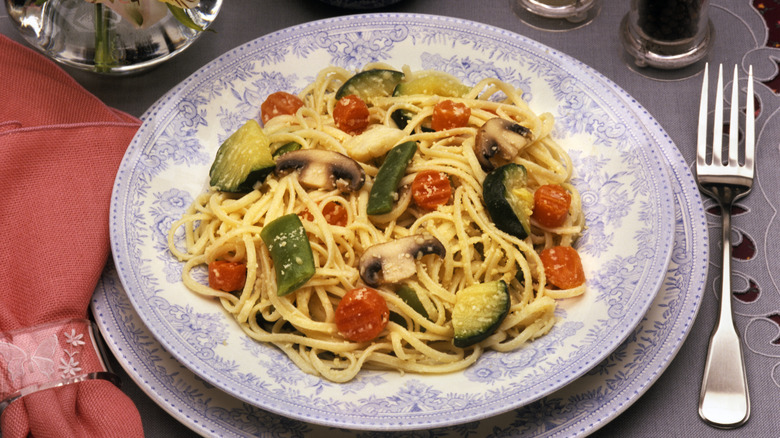9 Old-School Pasta Dishes That Have Nearly Vanished
The beauty of pasta lies in its endless variations. Talk to anyone you know and they will have a different favorite noodle dish, whether it's carbonara, ramen, or spaghetti and meatballs — and, occasionally, their favorite dish might be one you've never even heard of.
Pasta has been around for thousands of years, leaving a mark in cuisines all across the world over time. Naturally, a few of these dishes aren't necessarily the talk of the town nowadays. In the 20th century, pasta became a staple in American restaurants and households, and with this came funky and at times confusing takes on pasta, many of which haven't survived to today. Besides the usual suspects of pasta recipes — which always make for an easy weeknight dinner — there are a number of vintage dishes that have been all but lost to time, hardly making their way to dinner tables anymore. Is it time to bring these old-school pasta dishes back? We'll let you be the judge.
Chicken tetrazzini
A forgotten gem of the bygone casserole era, chicken tetrazzini is a baked spaghetti dish that is a great use of leftover chicken — or, in the few days after Thanksgiving, leftover turkey. Supposedly invented in the early 20th century as a tribute to opera singer Luisa Tetrazzini, the hearty meal grew very popular in the latter half of the 1900s. Despite its Italian name, tetrazzini is an American dish; one of its many purported places of origin is San Francisco at the Palace Hotel.
Chicken tetrazzini is packed with mushrooms and chicken, which are suspended in a creamy Parmesan sauce. Back in the day, people often used canned soups, such as cream of mushroom, as a base for the sauce. The richness of the dish makes it a great meal for the family. Past its craze in the middle of the century, the dish fell out of fashion, possibly due to an increased consciousness towards healthy cooking. Nowadays, the dish is rare but holds a special, nostalgic allure for many across the United States.
Tuna noodle casserole
Like a haunting ghost, either completely sinister or jolly and kind, tuna noodle casserole's presence could be felt in many 20th century American homes. The polarizing combination of ingredients is understandable: tuna, mushrooms (or, as was common, cream of mushroom soup), cheese, and some sort of crunchy topping are baked in a casserole. Depending on who you are, this will either be delicious or decidedly not delicious.
Traced to the 1920s in the Pacific Northwest, tuna noodle casserole started as a regional dish but exploded in popularity due to its conveniently processed ingredients. Whether they have fond memories or horrified ones, tuna noodle casserole left a lasting impact on your parents and grandparents. It might be worth making some of your own, like this upscale tuna casserole recipe that will make you question what you really know about the wonders of this dish.
Frankaroni loaf
Frankaroni loaf is one of those midcentury dishes that you might not believe is real until you see — or try — it yourself. But real it is: Found in a vintage recipe card, frankaroni loaf is a wild concoction of macaroni, hotdogs, processed cheese, and olives, along with a few other interesting ingredients. Apparently, even though the ingredients list itself is difficult enough to stomach, some brave cooks online have reported that the end result is greater than the sum of its parts. This culinary cacophony could very well be the cure to your cravings for, well ... something different.
Much like the vintage dish pasta Aquitania, which you won't be able to find in restaurants anymore, this baked noodle loaf is a perfect example of the laid back, casserole-style cooking that swarmed across the United States from the early 1900s on. The highly processed nature of the dish might not appeal to modern diners, but if you're feeling adventurous, I'm sure you won't forget whipping this loaf up.
Noodle rings
If a recipe has egg noodles sculpted into a whimsical, unexpected shape, chances are it is from a decades-past era of American cooking. This is exactly what a noodle ring is: close to a macaroni and cheese, noodle rings are a vintage comfort food made of noodles held together by a silky (and milky) bechamel sauce. They made their mark in Betty Crocker cookbooks and handwritten recipes passed down generations.
A noodle ring is another recipe that can make good use of leftover protein like chicken or turkey, which you can stash in the center of the ring before topping with a cheese sauce, a bolognese, or, in the true spirit of the times, a can of creamy soup. If you're concerned the general public has not honored this dish sufficiently, knock your festivities out of the park on National Noodle Ring Day on December 11 and remind everyone why this is a bygone classic.
Spaghetti salad
If the words "spaghetti" and "salad" don't really jive together for you, you're not alone. This mash-up was popular in the 1980s and is rare to see since. Made with a now defunct seasoning blend called Salad Supreme (which, under McCormick, is currently sold under the name Perfect Pinch), a proper spaghetti salad is a spiced, refreshing side dish. Recipes from the 20th century include cucumbers, tomatoes, onions, and bell peppers, and Italian dressing. In short, it is a painless appetizer or side that comes together as quickly as your spaghetti boils.
While many made this in their kitchens at home, spaghetti salad was also a popular ready-made item at grocery stores and delis in the '80s, especially in the Midwest. Essentially the pasta salad you know and love but with a stronger Italian flair, a spaghetti salad is begging to be brushed off and returned to your table. Upgrade the next pasta salad you make with this multi-stage dressing trick, replace the noodles with spaghetti, and you'll be glad you invited the 1980s into your home.
Chop suey
It may be surprising to those who remember chop suey — a dish of bean sprouts, water chestnuts, and other vegetables served over noodles or rice— to hear that it was not always the cheap household meal that was ubiquitous in the 20th century. In the early 1900s, this dish was found at fancier, high-class events like formal balls and plays. When American companies decided to can the dish and sell it on shelves, the exclusive stigma around the dish shifted.
In China, chop suey was originally a dish of meat intestines, but as it adapted to American palates, it eventually grew to the dish it is currently. There is also an even further Westernized version of the meal called American chop suey, which is a wild hybrid of Italian pasta noodles and Chinese flavorings. This dish had a grip on the American public for decades, endlessly adaptable but strikingly singular. It's still popular in some places, but has faded from its midcentury popularity.
Beef stroganoff
A once electrically popular gourmet dish in the mid-1900s, beef stroganoff has since taken a little bit of a backseat on peoples' celebratory tables and is remembered as a more humble offering today. Its slightly out of date elegance comes from food rationing during World War II, when beef was harder to come by and a beef stew would be a rare indulgence.
In the 1900s when it was invented, beef stroganoff was a Russian dish that included somewhat unorthodox ingredients such as allspice and tomato juice. More modernized recipes detail a hearty, mustardy stew that revels in its vintage glory. Both the older and newer recipes share a trademark addition that caps off the stew beautifully: A dollop of tangy, creamy sour cream. Make sure you use the best cut of meat for beef stroganoff, like a sirloin, and you'll sit at home wondering why this dish ever went out of style.
Pasta primavera
Despite a seemingly pure-blooded Italian name, pasta primavera is an American dish from the 1970s and is rare to see on menus in Italy. Peas, asparagus, broad beans, and sometimes other vegetables combine to make a light, verdant sauce. If you think this sounds like spring on a plate, you might speak Italian: primavera means "spring" in Italian, a name given to the dish by its inventor Sirio Maccioni.
As with most interesting pasta dishes, this one has a wacky origin story. Maccioni, on vacation in Nova Scotia, is said to have cobbled this dish together one day in 1975. He brought it back to his famous New York restaurant, Le Cirque, only to have it deemed not worthy of their kitchen by his chef partner. From then on, the dish found a home in American kitchens and restaurants, but eventually drifted from the limelight as awareness of culinary appropriation grew across the world. If you want to make your own version of this vintage classic at home, level up the pasta by grilling the veggies.

